The differences between text and chat messaging

Today’s consumers have high expectations for engaging with businesses. They expect to be able to contact a brand whenever they want and have a seamless, convenient experience every time.
Whether you're engaging with customers, managing online orders, or overseeing customer support, the way your brand communicates with customers can make a significant difference. You know you need a business messaging solution - such as in-app chat or SMS (text messaging) - so how do you choose the solution that delivers the best experience to your customers?
The decision depends on several factors, but it all starts with your business objectives. In this blog, we’ll explain the differences between in-app chat vs. text (SMS) to help you find the right fit for your brand.
Let’s first answer the question, “What is SMS?”
What is SMS?
SMS, or Short Message Service, is a text messaging service that allows people to send short text messages between phones. SMS uses standardized communication protocols to enable the exchange of short text messages between fixed-line or mobile phone devices. SMS is notable for its character limit, typically 160 characters per message, which facilitates concise communication. This service operates over the Global System for Mobile Communications (GSM) network, although it can also be used on other network technologies. It was originally defined as part of the GSM standards in 1985 and has since become a ubiquitous form of communication worldwide.
SMS is one of the oldest forms of text-based communication. It was invented in the early 1990s as the first broadly available peer-to-peer messaging service, allowing users to send and receive text messages of up to 160 characters. It has quickly grown in popularity since then.
SMS technology may seem simple, but there's a good reason why this channel has remained one of the most popular forms of communication for both personal and professional use over decades. Not only is it a reliable method, but it’s also extremely popular and widely available.
Today, SMS isn’t just used between friends and family, but it’s also increasingly used in application-to-person (A2P) messaging, which allows businesses to contact customers by sending a text from their application using an SMS API. Think about the code your bank sends when you try to log in from a new device — that’s an SMS API in action.
SMS is universally supported across all mobile devices, making it an accessible option for businesses to reach a wide audience. It's often used for:
Notifications and alerts: Banks, airlines, and other service providers use SMS to send time-sensitive alerts
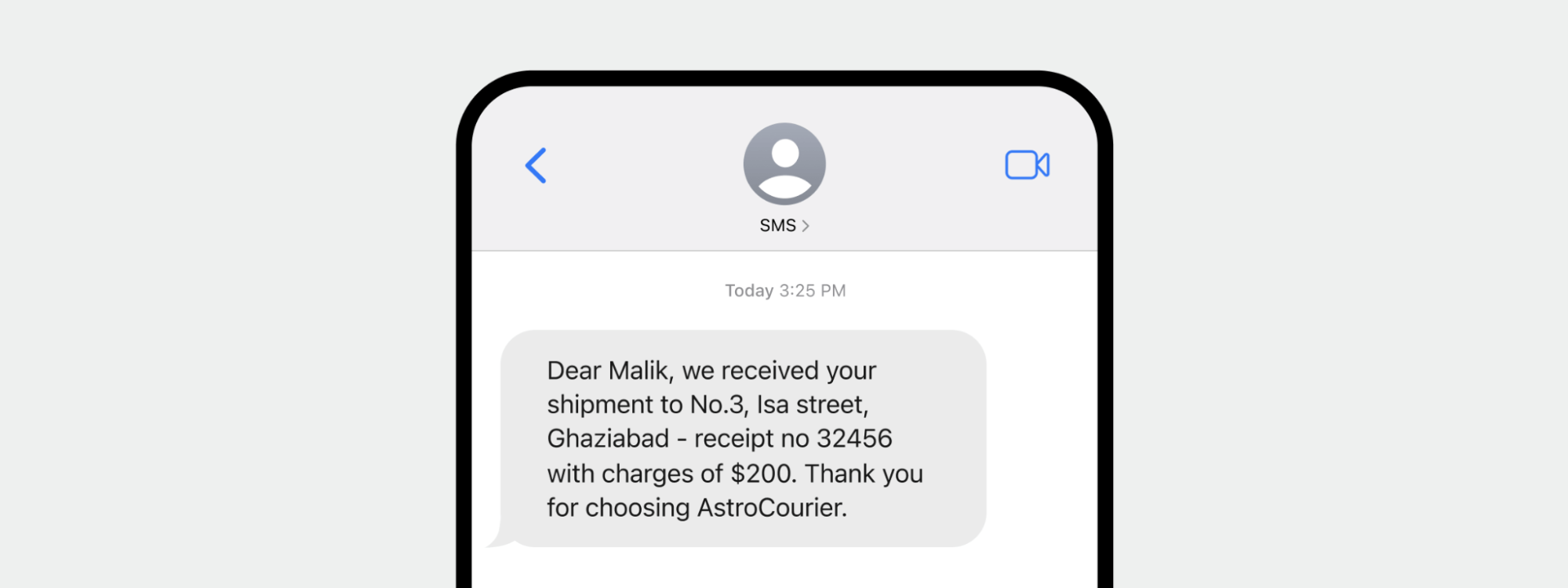
Marketing campaigns: Businesses across industries, especially in retail and eCommerce, use SMS for text marketing so they can reach customers directly with promotional offers and updates.
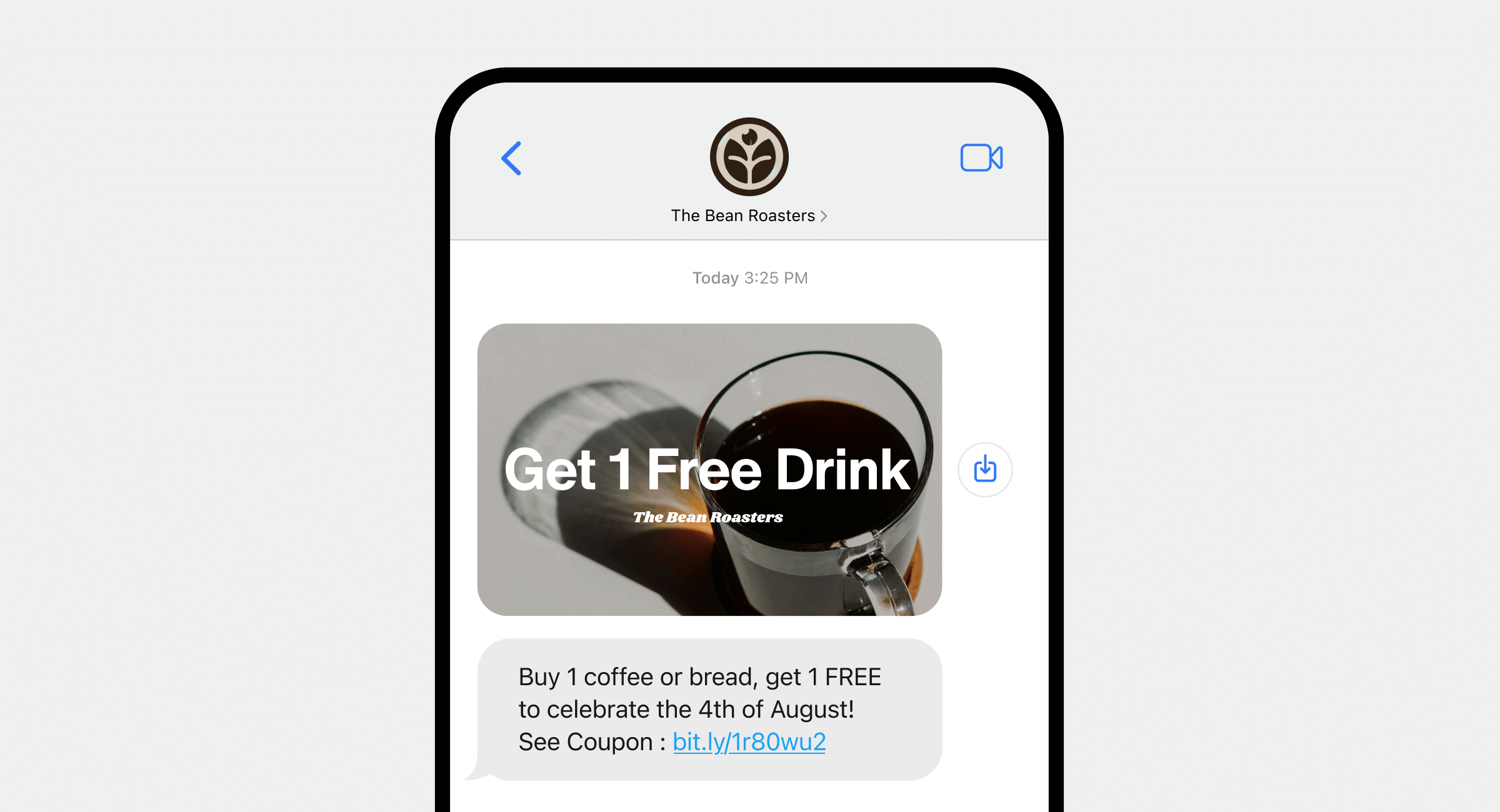
Customer feedback: Many companies use SMS to quickly collect customer feedback through short surveys.
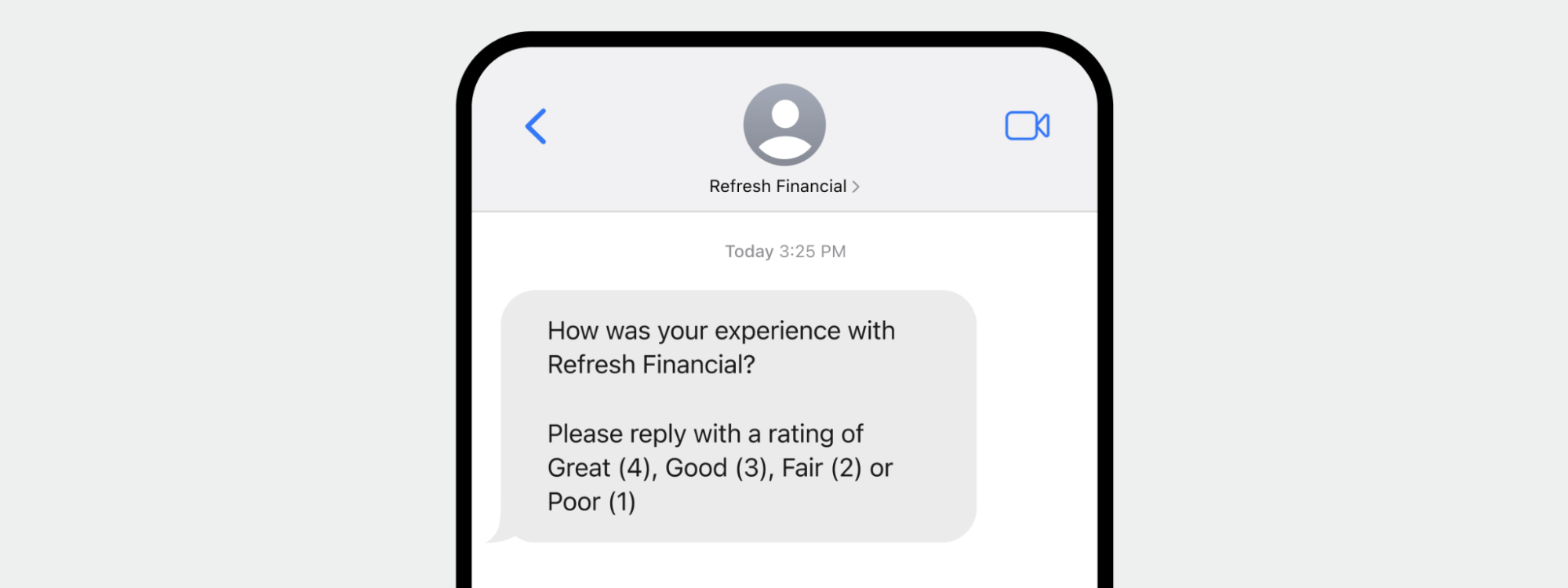
The popularity of SMS in business communication isn’t surprising, considering the statistics. As of 2024, over 5 billion people globally send and receive SMS messages, an impressively large audience. With an open rate of 98% — higher than any other channel — and 90% of text messages being read within three minutes, SMS is an incredibly effective channel for urgent communications and marketing efforts.
Where do chat messaging apps fit in?
Over time, the increasing accessibility of mobile data and cheaper data rates compared to high SMS fees and roaming charges in many countries gave rise to chat applications like WhatsApp, WeChat, Facebook Messenger, Telegram, Snapchat, and Tencent QQ, as shown in the chart below.
Top global messaging apps by monthly active users
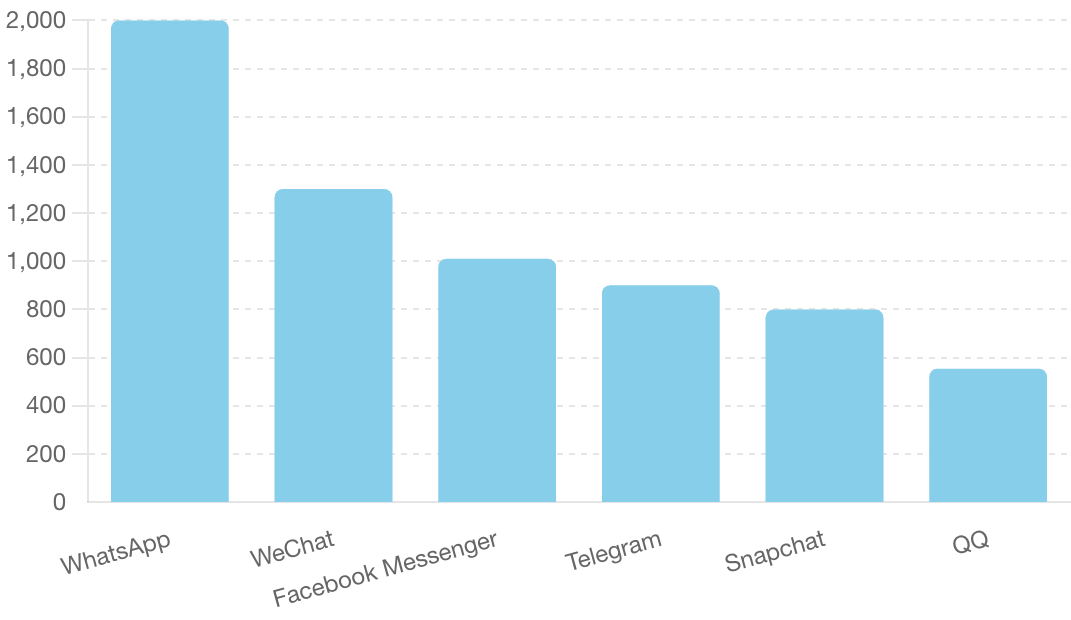
As we can see, messaging communications, whether SMS or other messaging apps, have become the preferred way for people to stay connected and share experiences with each other. The value of incorporating messaging into business communications strategies, therefore, cannot be overlooked.
What is in-app chat?
In-app chat is a messaging feature integrated directly within a mobile web application, allowing users to communicate in real-time without leaving the app. This functionality enhances the user experience by providing seamless interaction, support, and engagement opportunities. In-app chat is commonly used in customer service, social networking, gaming, and e-commerce apps, facilitating direct and instant communication between users and service providers or among users themselves.
In-app chat offers a rich set of features (similar to the best third-party chat apps), designed to enhance user interaction and boost engagement:
Real-time communication: Users can engage in live conversations, making it ideal for customer support and community or peer-to-peer interactions.
Multimedia support: Unlike basic SMS, in-app chat supports videos and files, resulting in a more dynamic communication experience.
Contextual conversations: Because the chat occurs within the app, users can seamlessly interact with the business while browsing products or services, reviewing past purchases, scheduling appointments, and more.
In-app chat is gaining traction, especially among businesses looking to better engage their users. Research shows that 63% of customers are more likely to return to a website that offers live chat, and businesses that use live chat within an app report 20% higher conversion rates.
Popular examples of in-app chat in action include:
Customers chatting with their food delivery provider inside a delivery app
Two people chatting to get to know each other in a dating app
A chat between a doctor and patient to perform a remote diagnosis in a healthcare app
As the demand for personalized and immediate communication grows, in-app chat is becoming a vital tool for businesses looking to improve customer experience and satisfaction.
The difference between chat messaging and text messaging: Chat vs. SMS
Feature/Aspect | In-app chat | SMS |
Ease of use | Integrated within app; the app requires installation | Universal, no installation needed |
User experience | Seamless, multimedia support | Simple, text-based |
Accessibility | Requires internet and app | Works on all mobile devices |
User engagement | Real-time, personalized | High open rate, less dynamic |
Implementation costs | Higher, involves development and integration | Lower, based on SMS service access |
Maintenance costs | Ongoing, server and updates | Scalable, per message cost |
ROI | Higher potential through engagement and retention | Immediate reach, diminishing returns if overused |
Integration | Smooth integration with app features | Limited, standalone |
Flexibility | Supports rich media, automated bots | Primarily text, basic automation |
Let’s compare the differences between in-app chat and text messaging (SMS) using some common criteria.
1. Ease of use
The easier a channel is to use, the more likely it is to be an effective method for your business. Chat and text messaging offer different advantages in terms of user experience, accessibility, and convenience.
User experience
In-app chat and text messaging (SMS) both offer unique user experiences tailored to their platforms. In-app chat messages provide a seamless experience that keeps the user in the app at all times, while SMS is a universally familiar interface that doesn’t require an app download.
Let’s look at in-app chat first. In-app chat:
Provides a seamless, integrated experience within the app, keeping the user on the platform the whole time.
Users can engage with support while exploring the app, leading to a more cohesive experience.
Rich multimedia support enhances the interaction, letting users share images, videos, and documents easily.
In comparison, the user experience for SMS can be described as:
Universally familiar and simple to use, requiring no additional app downloads.
Limited to text and basic multimedia, making it less dynamic than in-app chat.
Having high accessibility as every mobile device supports SMS.
Accessibility and convenience
Accessibility is an extremely important consideration today, not to mention how convenient the method is for consumers. Let’s take a look. In-app chat is a better fit for users who are already active on the app, while SMS is ideal for those without a smartphone or reliable internet connection.
With in-app chat, we see that it:
Requires users to have the app installed and an active internet connection. Depending on how the app is designed, it may not be as accessible for users with special requirements.
Is best suited for existing customers who frequently use the app.
SMS, on the other hand:
Works on any mobile device, with no internet connection required.
Is ideal for reaching a broad audience quickly, including those without smartphones or who may not have the app installed.
The primarily text-based format makes meeting special user needs (accessibility) easier.
2. Engagement and retention
Keeping users engaged is critical to retaining customers for longer, which in turn increases their lifetime value to a business. Considering that 90% of smartphone users continue shopping if they have a great user experience, the stakes are high to keep customers engaged through your chosen communication method.
User engagement
Because of their different capabilities, engagement levels can vary widely between in-app chat and SMS.
In-app chat:
Facilitates real-time interaction, which can lead to higher user satisfaction and loyalty.
Supports personalized interactions within the app, fostering a deeper connection with users.
SMS:
Is highly effective for quick, attention-grabbing messages due to its high open rate.
Has limited interaction capabilities, which can result in less engaging experiences over time.
User retention is closely linked to engagement. For in-app chat, brands that use personalized chat messages report user retention rates between 61-74% within 28 days, compared to 49% or less for generic campaigns. This shows that personalization pays off when it comes to keeping customers around for longer.
3. Cost and ROI
It’s important to weigh setup and long-term costs when determining the right communication methods for your business. In-app chat messages and text messages come with different budget requirements and long-term investments.
Comparative costs of implementation and maintenance
Scalability and maintenance concerns also need to be factored into the choice between SMS and chat.
In-app chat considerations include:
Initial setup: Higher costs due to the need for integration and development within the app.
Maintenance: Ongoing costs include server maintenance and updates.
Whereas, with SMS, we see:
Initial setup: Lower setup costs; simply requires access to an SMS service. However, it’s important to consider the cost to the customer, which can be high depending on the geographical region.
Maintenance: Costs are typically based on the number of messages sent, making SMS relatively scalable depending on the provider.
Long-term return on investment
What does the ROI of these channels amount to over time? The numbers are telling.
In-app chat statistics:
In-app messages can boost retention rate by 30% when they’re implemented well, leading to more purchases and higher customer lifetime value.
Businesses that use in-app chat report a 20% increase in conversion rates over time.
SMS, in contrast:
Offers quick wins with high open rates of up to 98% and immediate reach.
Effective for time-sensitive campaigns and urgent communications, but may see diminishing returns if overused.
4. Integration and flexibility
Integration with your tech stack is another critical consideration, as is the flexibility of capabilities and communication styles.
Integration with other app features
If you want to offer customers a more cohesive customer experience, integrating your comms with other channels and features is key. While in-app chat offers seamless integration with other app capabilities, SMS has limited integration options; SMS, therefore, functions better as a standalone method. Let’s dive deeper into how in-app chat vs. SMS stack up.
In-app chat:
Integrates smoothly with other app functionalities like user profiles, shopping carts, and activity logs.
Can be customized to match the brand’s look and feel for a more consistent user experience.
SMS:
Limited integration capabilities; primarily stands alone as a communication method.
Can be used alongside other channels like email and push notifications for a multi-channel approach.
Flexibility in communication styles and capabilities
Using different types of media can help keep users more engaged and active. In-app chat shines in this department with rich media options and real-time communication, whereas SMS is primarily text-based and lacks the asynchronous nature of chat messaging.
In-app chat:
Highly flexible, it supports rich media, real-time conversations, and complex interactions.
Allows for automated chatbots to handle common queries, helping resolve customer queries more quickly and increasing customer satisfaction.
SMS:
Less flexible, mainly text-based, with limited multimedia support, depending on the provider.
Can leverage SMS automation for tasks like appointment reminders and promotional messages, but doesn’t offer a real-time communication experience.
Benefits and limitations: In-app chat vs. SMS
When considering chat vs. text for your brand’s communication strategy, each method comes with its own set of pros and cons. We’ll explore each method in detail to help you make an informed decision between text and chat.
So, what’s the scoop on SMS? Here’s a quick overview:
Benefits & limitations of using SMS for brand communications
Benefit | Limitation |
Ubiquitous: SMS is supported by every mobile phone | Character limit: 160-character length restriction limits the amount of information included |
Easy and familiar to use: Your target audience likely understands SMS already | Perceived as spam: Can be confused with spam, especially if not personalized or sent frequently |
High open rates: Open rates are reportedly as high as 98% | Users must leave app: Disrupts user experience |
No Internet required: Messages can be delivered and read regardless of Internet availability | One-sided: Isolating, disjointed UX |
Reply ‘Stop’: Reply stop to unsubscribe from text alerts | Doesn't support rich multimedia: No photos, videos, voice and other media |
Cost-effective for short messages: Can be affordable for brief communications, especially with bulk messaging rates. | Cost implications: Costs can add up for high-volume messaging campaigns, given per-message costs and carrier fees |
SMS fatigue: SMS is not as popular as in the past, and many consumers’ inboxes are already filled with marketing SMS messages |
Benefits of SMS
Many of the benefits of SMS revolve around its nearly unbeatable open rate and the fact that this method doesn’t require an internet connection. Additional benefits include:
High open rates: SMS has an impressive open rate of 98%, with most messages read within 3 minutes of receipt. This makes it especially useful for urgent and time-sensitive communications.
Ubiquity and ease of use: SMS is universally supported on all mobile devices without needing to download an app. This makes it an accessible communication method for reaching a broad audience.
No Internet required: Unlike other digital communication methods, SMS doesn’t require an Internet connection. This means messages can be delivered and read regardless of internet availability, making it the best option for areas with poor connectivity.
Cost-effective for short messages: SMS can be a cost-effective option for brief communications and reminders, especially for businesses that negotiate bulk messaging rates.
Limitations of SMS
The ubiquity of SMS does come with a downside; the channel is relatively standalone and relatively harder to integrate with other channels. Some other drawbacks include:
Character limit: SMS messages are limited to 160 characters, which limits the amount of information you can include in a single message. Longer messages could be split into multiple texts, which could lead to confusion.
Cost implications: Although SMS can be cost-effective for short messages, costs can quickly add up for high-volume messaging campaigns unless your business can take advantage of bulk messaging rates. It's important to consider per-message costs and potential carrier fees.
Lack of multimedia support: SMS is primarily text-based and offers limited support for multimedia content. This can limit the richness of the communication and user engagement compared to in-app chat and other messaging platforms.
Opt-in requirements: Regulations require that users opt in to receive SMS messages, which can be a barrier to reaching a wider audience. Managing opt-in and opt-out lists can also be cumbersome.
Perceived as spam: SMS's simple, text-based nature can lead users to think messages are spam, especially if they aren't personalized or if your brand sends text messages too frequently.
Benefits & limitations of in-app chat
What about in-app chat? Here’s a quick overview:
Benefit | Limitation |
Supports rich multimedia: Users can send rich media files | Requires an app: The user must download the app to access chat |
Builds communities: Real-time communication and user-to-user chat create a community within and around your app, making it more personal | Requires an internet connection: User loses access when disconnected |
Drives engagement and retention: Users draw one another back into the app and form meaningful connections | Users must allow push notifications: User can opt out of push notifications by changing their app permissions |
Contextualized communications: Brand messaging takes place within the context of the app, where it is expected | Higher up-front investment: Building an app and integrating in-app chat comes with high initial costs. |
Data-rich: Interaction data/chat history available | User onboarding: Need to educate users on how to use the app. |
Seamless integration: Easily integrates with other app functionalities and capabilities | Privacy concerns: Need to build robust security measures into the app. |
Consistent branding: Customize branding for a consistent customer experience | |
Automated chatbots: In-app chat supports AI chatbots, driving efficiencies for customer support |
Benefits of in-app chat
Let's start with the benefits of in-app chat. Notable advantages include its seamless integration with other app functionalities and how it supports community building with user-to-user interaction. Additional pros include:
Rich multimedia support: In-app chat supports a range of multimedia content, including images, videos, and documents. This allows brands to engage users with more dynamic communication.
Enhanced user engagement and retention: By providing real-time, interactive communication within the app, in-app chat can significantly boost user engagement and satisfaction. Push notifications can alert users to new messages, keeping them engaged with the app.
Supports community building and human connections: With real-time user-to-user chat, users organically build community, deepening their engagement and loyalty to your brand. Plus, chat allows you to interact with users in a more human way. Conversational signals like presence and typing status make the conversation feel more synchronous and help build engagement.
Better integration with app functionalities: In-app chat seamlessly integrates with other app features like user profiles, shopping carts, and activity logs. This allows for a more cohesive user experience and contextual communication.
Customization and branding: Businesses can customize the chat interface to match their branding, helping them deliver a consistent, professional appearance.
Rich customer data: Brands have access to customers’ user data, generating rich insights and valuable first-party data.
Automated chatbots: In-app chat can leverage AI-powered chatbots to handle common queries, providing instant responses and freeing up human agents to handle more complex queries.
For example, a buyer on a marketplace chat thread can look at a product image, watch a video, click on a coupon code, initiate a purchase, track their order status, and fill out a review from within the chat.
Some other pluses include:
The fact that users don’t need to hand over their phone number, which many people are reluctant to do.
Push notifications alerting users to chat messages from other users can draw users back to your app.
Some chat platforms provide offline messaging, caching unsent messages and sending them when the user comes back online so they don’t have to worry about deliverability issues.
Limitations of in-app chat
In-app chat comes with a few cons that are important to understand before making a decision, including the need for internet connectivity and higher up-front costs. Other cons include:
Requires app download and internet: Users need to download the app and have an active internet connection to use in-app chat. This can be a barrier for users with limited storage space or poor internet connectivity. Brands with large international customer bases should do their research into internet access in their target countries.
Dependency on push notifications: In-app chat relies heavily on push notifications to alert users to new messages and reminders. If users disable push notifications, they may miss important communications, diminishing the effectiveness of in-app chat.
Higher initial costs: Developing and integrating in-app chat features can be expensive. Businesses need to invest in development, implementation, and ongoing maintenance.
User onboarding: Ensuring users are comfortable and familiar with the in-app chat feature may require additional onboarding efforts and customer education.
Privacy concerns: Handling sensitive information through in-app chat requires robust security measures to protect user data, adding to the complexity and cost of implementation.
Ultimately, the decision between in-app chat and text (SMS) comes down to your brand’s specific use case. In the next section, we’re exploring some common use cases for in-app chat vs. SMS.
Use case scenarios: In-app chat vs. SMS
When you get down to it, how do in-app chat and text (SMS) compare when it comes to specific industries? We’ve put together some use cases to help paint a clearer picture.
Industry | In-app chat application examples | SMS application examples |
E-commerce | Real-time customer support during shopping | Abandoned cart reminders with discount codes |
Healthcare | Patient-doctor communication, sharing test results | Appointment reminders |
Education | Student-faculty interaction, sharing resources | Urgent notifications about schedule changes |
Gaming and social apps | Building community, real-time interaction in user-to-user chat | Re-engagement of inactive users |
On-demand services | Real-time communication between delivery driver and customer | Promotional text with a promo code |
E-commerce
In-app chat
Scenario: A customer is browsing an online clothing store, and needs help to choose the right size for a specific dress.
Application: The in-app chat allows the customer to instantly connect with a support representative without leaving the app. The representative can provide size charts, images of models wearing the dress, and even videos. This real-time assistance helps the customer make a more informed decision, increasing the likelihood of a purchase. Plus, the rep can suggest other items based on the customer's preferences, further enhancing the shopping experience.
Benefits:
Immediate, personalized support
Ability to share multimedia (images, videos, size charts)
Increased customer satisfaction and conversion rates
SMS
Scenario: A customer has added items to their cart but hasn’t completed the purchase.
Application: The e-commerce platform sends an SMS reminder about the abandoned cart. The message includes a direct link to the cart, a special discount code to incentivize the purchase, and a customer service number for any questions. This presents a strong call to action to prompt the customer to complete their purchase.
Benefits:
High open rates ensure the reminder is seen
Quick and direct link back to the shopping cart
Effective for urgent, time-sensitive reminders
Healthcare
In-app chat
Scenario: A patient needs to discuss ongoing symptoms with their doctor and upload recent test results for review.
Application: The patient uses the healthcare provider’s app to start a chat with their doctor. They upload and share their test results and receive real-time feedback from their doctor before discussing next steps. The doctor sends some educational materials and then directs the patient to schedule an in-person appointment within the app.
Benefits:
Secure, real-time communication
Easy, secure sharing of medical documents and images
Better patient engagement and follow-up
SMS
Scenario: A patient has a scheduled appointment next week and needs a reminder.
Application: The healthcare provider sends an SMS reminder a few days before the appointment, including the date, time, and location. The message also contains a link to reschedule if necessary.
Benefits:
High open rates increase the likelihood of the user seeing the reminder
Simple, effective way to reduce no-shows
No internet connection required
Education
In-app chat
Scenario: A university wants to enhance student engagement by providing a platform for real-time communication between students and faculty.
Application: The university’s app includes a chat feature where students can ask professors questions about assignments, participate in group discussions, and receive instant feedback. Professors can also share multimedia resources and announcements directly through the chat.
Benefits:
Real-time interaction with faculty and students
Enhanced engagement through multimedia sharing
Seamless integration with other educational resources
SMS
Scenario: A school needs to send out an urgent notification about a change in the class schedule due to unforeseen circumstances.
Application: The administration sends an SMS to all students and parents with the updated schedule and any additional instructions.
Benefits:
Immediate delivery and high open rates
Communicates critical information quickly
Effective for urgent notifications
Gaming and social apps
In-app chat
Scenario: A gaming app wants to build a community by enabling players to interact in real time.
Application: The app includes an in-app chat feature where players can discuss strategies, form teams, and share their gaming experiences. The chat supports multimedia, allowing players to share screenshots, videos, and links to game resources.
Benefits:
Fosters a sense of community and collaboration
Real-time interaction and user-to-user chat enhances the gaming experience
Supports multimedia for richer communication
SMS
Scenario: A social app wants to re-engage users who haven’t logged in for a while.
Application: The app sends an SMS to inactive users with a personalized message encouraging them to return. The message includes highlights of recent updates and a link to download the latest version of the app.
Benefits:
Direct and personal way to re-engage users
High open rates increase the chances of users returning
Effective for driving app downloads and updates
Ideal method for reaching users who turned off in-app notifications
On-demand
In-app chat
Scenario: A customer placed an order for food delivery through an on-demand delivery app. The delivery driver is en route to the customer’s location and needs to confirm the delivery address.
Application: The delivery driver uses the in-app chat feature to send real-time messages to the customer. They confirm the address and receive their community’s gate code from the user.
Benefits:
Real-time interaction, ensuring immediate updates and responses
Keeps all communication within the app so both parties can refer to previous messages if needed
Seamless and professional communication channel
Keeps personal phone numbers private, enhancing security and privacy
SMS
Scenario: An on-demand services company wants to increase customer engagement and drive more orders during a slow period. To this end, they decide to send a promotional text message with a discount code to all registered users.
Application: The company sends an SMS to its customer base with a special promo code for a discount on their next order. The message highlights the value of the offer and includes a link to order inside the company's app, encouraging immediate use.
Benefits:
With a 98% open rate, chances are high that the promotional message will be seen
No internet required
SMS can reach a wide audience regardless of the type of mobile device they use
For short and direct messages, SMS is cost-effective
Getting started with in-app chat
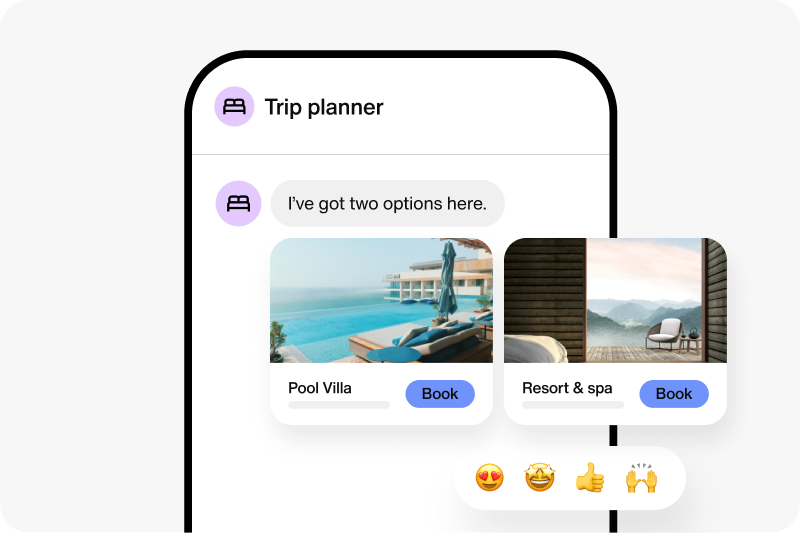
If you’re ready to take the next step with in-app chat for your business, it’s important to partner with a chat API provider that aligns with your goals and meets all of your needs.
Sendbird Chat is an ideal chat API for businesses looking to integrate robust messaging capabilities into their apps. It’s designed to provide seamless, real-time communication for users, helping enhance engagement and improve overall user experience.
The chat API offers an extensive suite of features that make it a powerful tool for businesses:
Real-time messaging: Facilitates instant communication between users with low latency.
Rich media support: Allows the sharing of images, videos, files, and other multimedia content.
Customization: Tailor the chat interface to match your brand’s look and feel.
Group and one-on-one chats: Supports both individual and group conversations, making it versatile for various use cases.
Push notifications: Keeps users engaged by notifying them of new messages even when they aren’t active in the app.
Moderation tools: Includes features like user reporting, content filtering, and automated moderation to maintain a safe and friendly environment.
Sendbird chat for online dating: Hinge case study
The popular dating app, Hinge, was looking to improve the virtual dating experience during the initial lockdowns of the COVID pandemic. The company implemented Sendbird's chat solution and went to market within 10 weeks. With such rapid deployment, users were able to continue dating virtually during the pandemic, maintaining strong engagement and satisfaction.
Hinge experienced 100% chat uptime and saved significantly on engineering resources. Not only were users highly engaged, but they quickly came to trust Hinge’s app experience for secure, reliable communication as they navigated an altered dating world. Read their full story here.
Getting started with SMS messaging
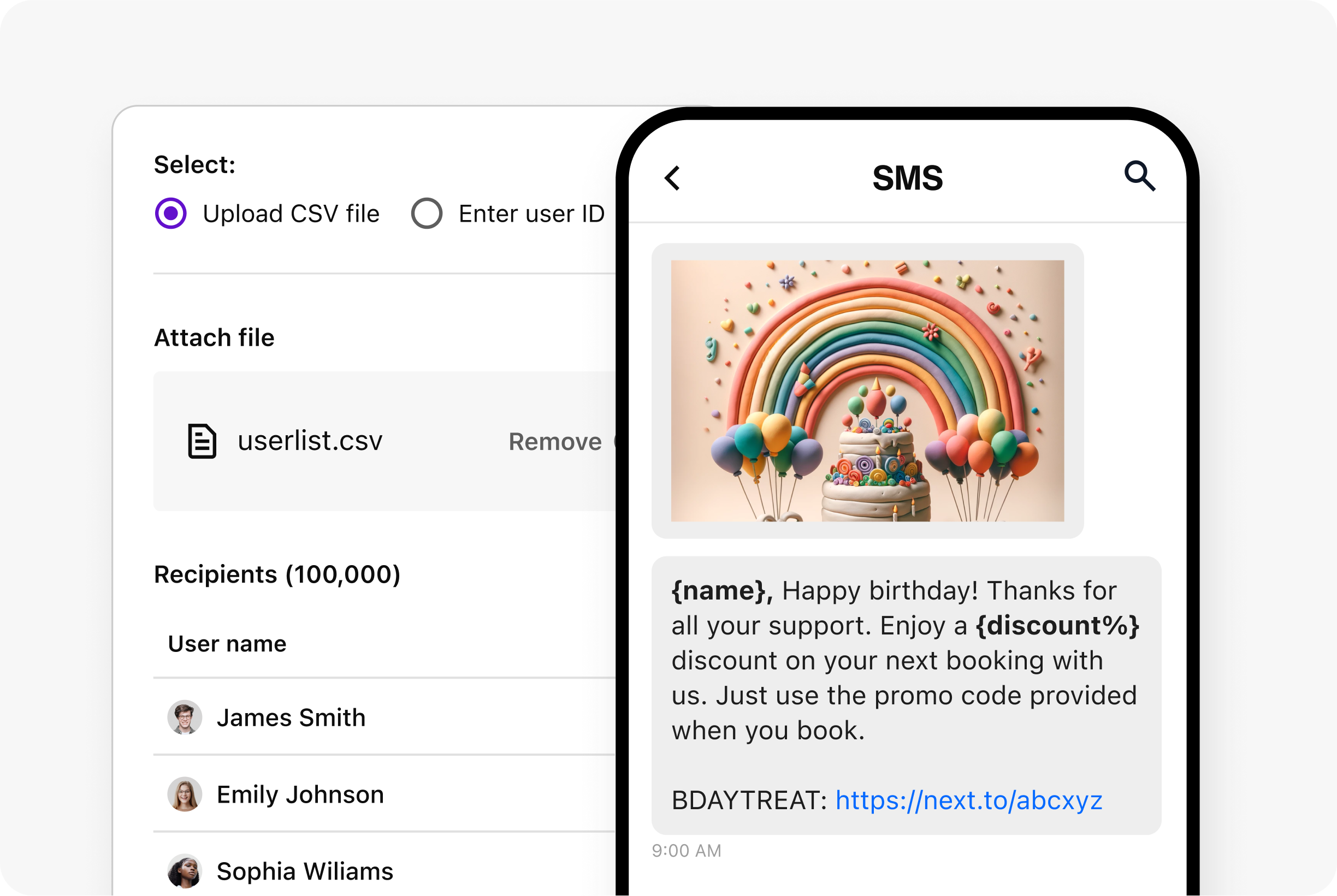
If SMS is the right fit for your brand, finding a reliable SMS API provider to facilitate a smooth text messaging experience is critical to making this method a success.
Sendbird offers a well-supported SMS API for businesses that want to leverage the power of text messaging for communication. This solution provides a reliable, scalable, and efficient way to send SMS messages to users worldwide.
Sendbird’s SMS solution, as part of Business Messaging, offers several features that make it a valuable tool for business communication:
Global reach: Allows you to send SMS messages to users across the globe.
High deliverability: Ensures that messages are delivered quickly and reliably.
Automation: Allows for automated messaging workflows like appointment reminders and promotional campaigns. This is especially useful as part of an omnichannel strategy.
Analytics and reporting: Provides detailed analytics to track message delivery, open rates, and user engagement.
Compliance: Ensures compliance with global messaging regulations and opt-in requirements.
Sendbird’s SMS solution for home services marketplace: Miso’s story
Korean on-demand marketplace for home services, Miso, was struggling to manage complex one-way and two-way communications for transactional, marketing, and operational messages across various channels, including SMS. After implementing Sendbird's omnichannel messaging solution, including Sendbird SMS, Miso significantly improved its communication efficiency and user experience. The integration allowed Miso to send all types of messages seamlessly across various channels, including SMS, push notifications, in-app messages, and Kakao Alert. This streamlined experience ensured that critical communications were timely and effectively delivered, enhancing the overall reliability of their service.
The streamlined messaging approach resulted in estimated cost savings of 43%, increased partner engagement, and an improved customer experience. By blending SMS with in-app chat and other channels, Miso gave users consistent access to important information, reducing missed messages and enhancing satisfaction. Read their full case study here.
Choosing the right solution: In-app chat or text?
We've explored the key differences between in-app chat vs. text (SMS), including their benefits, limitations, and ideal use cases for various industries. In-app chat excels in providing rich, real-time interactions within the app, making it perfect for enhancing user engagement and integrating seamlessly with other app functionalities. On the other hand, SMS offers high open rates, simplicity, and broad accessibility, making it ideal for urgent and time-sensitive communications.
Which option is right for your business: In-app chat vs. text messaging
Choosing between in-app chat and SMS largely depends on your business's specific needs and objectives. And keep in mind that it doesn’t have to be an either-or decision. If an omnichannel strategy makes sense for your brand, Sendbird can support you across channels, including in-app chat and text messaging.
That being said, here are some general recommendations:
For businesses focused on real-time customer engagement and retention, especially in e-commerce, on-demand, and gaming, in-app chat is an excellent option. Its ability to provide personalized, multimedia-rich interactions in real-time can significantly increase user satisfaction and loyalty.
For businesses that require timely marketing messages, reminders, and broad reach, like those in retail and healthcare for appointment reminders and promotional campaigns, SMS is a reliable and effective tool. Its high open rates ensure that critical messages are seen promptly.
Ultimately, integrating both in-app chat and SMS into your communication strategy can provide the best of both worlds, allowing you to engage users dynamically within the app while reaching them reliably through SMS when necessary.
If you’re ready to enhance your business communication with robust messaging solutions, Sendbird can help. With Sendbird Chat and Business Messaging for SMS, your business can implement powerful APIs to integrate these features into your strategy seamlessly.










